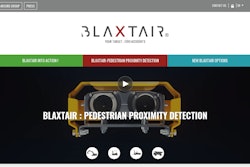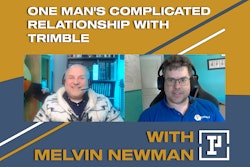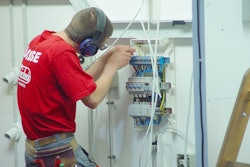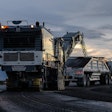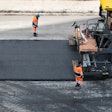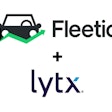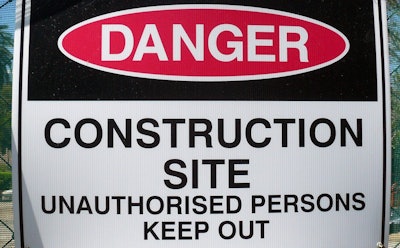
Many construction enterprise resource planning (ERP) and project management tools will have a risk register, and other functionality for visibility into safety, financial, legal and project risk, or even natural disasters.
While these tools can help identify and prioritize risk, then plan for and delegate responsibility for risk mitigation, technology can also reduce risk proactively by automating functions with artificial intelligence (AI). AI has a role to play in risk management software as well—companies like Newmetrix is proving this with operations while Zetane, Patabid are pioneering AI-driven risk mitigation in estimating and ProNovos has a working solution. Clash detection in building information management (BIM) applications could be considered another form of AI-driven risk management tech.
But here, we will focus not on tech for identifying risk, but AI technologies that engineer risk out of construction projects and business processes.
WINT Water Intelligence
Water leaks and internal plumbing during and after construction can bring a construction project to a halt, require expensive rework and result in costly litigation. Founded in 2011, New York City-based WINT develops AI-driven systems used on major projects to save water, reduce consumption, and prevent water leaks. The advanced algorithms that drive the application can detect a leak and send up an alert, and then shut water off as the situation worsens.
“Let’s say you have a leak on the fifth floor of a structure—which can happen often in later phases on construction sites,” WINT Chief Product and Strategy Officer Yaron Dycian said in a February 2022 debriefing call with IronPros. “It can flow like crazy. Below that, you see a damage situation. Maybe someone stuck a nail in a wall and hit a pipe or there was a bad fitting. Over some time, water degrades the area of the leak, and the water flow increases. As the water pressure drop continues, maybe someone notices some wetness somewhere. The pattern is an increasing, escalating leak or a degrading pipe burst. It is a really bad situation. Our technology can be configured to first alert someone to the situation and then shut off the water supply.”
At the time of our debriefing call, WINT was a 70-person company that the previous month had secured a $15 million series B funding round led by New York-based global private equity and venture capital firm Insight Partners. The round also included numerous global construction and real-estate companies, including Suffolk Construction, a national technology-driven general contractor, the Consensus Business Group, Tidhar, Electra, Ashtrom and real estate entities Tidhar and Israel Canada.
The product set is comprised of a cloud-based AI application and an edge unit. The edge unit consists of a standard off the shelf water flow meter and electronically-controlled valve and a proprietary control unit from WINT that connects valves and meters and processes the data from the meter in real time. The algorithms that spot anomalies in water flow and trigger alerts and water flow stoppages reside on this edge unit. The cloud component of the software lives on Amazon Web Services and communicates with the edge unit over a cellular signal. In our debriefing call, Dycian told me the technology did not support alternative means for connecting the edge unit to the cloud, like a satellite uplink, but that the size of structures and projects the technology was used on meant cellular service was generally available. But the anomaly is detected by the edge device which can shut off water service without access to the cloud component, in the event of cellular outage. Ethernet or wifi connectivity is also on the roadmap, according to Dycian.
The AWS-based tech stack controls and manages the data, records it to strengthens the already deep data set the machine learning application relies on and enables users to configure triggers for alerts versus water shutoff.
There are other technologies that shut off water based on leak detection, but WINT brings a degree of sophistication that is more reliable in terms of detecting leaks while minimizing false positives, which can be a significant annoyance to contractors or, after commissioning, facilities managers. End users can configure the algorithm, setting a threshold for the maximum volume allowed to to spill on the project site. Algorithms can be made to work differently at different times of day, and users can set recurring controls to behave differently during work hours than off hours, or during a big concrete pour when fewer hands are on deck to mitigate any problems detected. This can also be done on an ad hoc basis, from mobile app, so as availability to intervene changes, a user can change the behavior of the system for a certain number of hours.
We go through an engineering process where we plan where to provide the protections. The cost then breaks down off the hardware which is not a profit center. Customer can buy directly. We layer service on top of that—duration per systems
Market and Price
WINT could be a viable technology for any contractor, regardless of size, as long as they are involved in larger building projects, starting at about $40 million to $50 million in value. Current customers include multiple ENR Top 50 contractors.
“We don’t exclude anyone if they have the right project his size,” Dycian said. “If they are doing smaller projects, depending on what they are doing maybe it still makes sense. We don’t see the market as divided by size. The world of contractors is however split into those who have had disastrous water leaks and those who will. Even contractors with smaller projects do appreciate this if they have had the pain.”
System price is determined in an engineering process where in an engineering process that determines where the hardware should be installed and the total number of units. The cost then breaks down between hardware, which the customer can buy directly, and the cloud-based service which is priced on duration of the project and number of hardware units.
WINT is currently setting up relationships with consulting engineering firms who can help them scale their capacity for specifying the systems and likely introduce them into new project settings, which could help them gain a dominant foothold on large projects.
Billy Eliminates Insurance Exposures
New York City-based Billy applies AI to the construction risks that stem from uninsured or under-insured contractors working on a job site. The startup, which has received in October of 2021 $3.5 million in seed capital from some of the who’s who of construction and real estate technology investors including Shadow Ventures, Laguna Canyon Group and MetaProp. The company employed about 10 at the time of our February, 2022 debriefing call, but planned to scale to 25 to 30 within the year. This growth would likely increase their capacity to get customers live by augmenting the one full time position focused on customer success. Billy had about a dozen customers at this point.
Many enterprise software tools including risk management, project management and enterprise resource planning (ERP) and project management solutions, will claim to address tracking insurances. But most will just record when an insurance certificate expires and prompt someone to take action.
Billy CEO and Founder Nyasha Harmony Gutsa and Co-Founder Grant Robbins come from backgrounds in construction and technology, with Gutsa also bringing insights from a stint in product marketing with Procore and additional tech sector roles.
The two realized insurance and indemnity tracking and management is, in most software products, still reliant on human beings. Individuals working in the software need to not only create a recorded reflecting the indemnity required to mitigate risk on a subcontract, configure the indemnity requirement in the software and attach that to the subcontract. Software will commonly enable notification if insurance certificates expire at various points in the process, from awarding the subcontract to payment of invoices. Subcontractors typically submit certificates of insurance as PDFs, which a project manager or administration team will need to compare to the project limit and manually enter that for every policy—for every subcontractor on every project.
What Billy does is digitize and automate this process, using AI to read static PDF certificates of insurance submitted. There is a reason contractors find that they or their subcontractors find themselves under-insured and getting sued. The problem of tracking indemnities is too complex for humans alone.
“People come with very large sets of vendors and realize maybe the way they are doing things is not as efficient as it should be,” Gutsa said. We ask them what their compliance rateis, and they may think it is 95 percent. But more often, contractors have a compliance rate below 15 percent.”
This shocking state of affairs is due in large part to the role of endorsements that may be required by given projects or owners, including:
Waiver of Subrogation, which limits the insurance company’s ability to collect money from someone else who may have been at fault for a claim
Additional Insured and Blanket Additional Insured, which extends one contractor’s coverage to other companies or entities
Per Project Limits that can specify that maximum coverage or liability limits can reset for each project
Primary/Non-Contributor which states the lower tier contractor’s insurance will pay first for any claims, shielding a general contractor
Non-Owned Auto Coverage to cover accidents happening when an employee is using their own vehicle to perform work
“The reason for such low compliance is because there are insurance requirements that vary by different types of contracts,” Gutsa said. “It is not a matter of collecting insurance—the endorsements are what really matters. Billy helps you reach out to your vendors, then you see documents coming in and see compliance rates going up. The other value Billy delivers is visibility of the types of insurance you have, and from which carriers? For all of the people who are coming on site, Billy looks at those details top see who is excluded from work on your project. Most worker’s compensation claims come from people who go on the project site, and nobody knows they are not supposed to be there because that information is only found on the certificate of insurance.”
“As you create a project, Billy automates getting information from subcontractors,” Gutsa said. “Certificates are submitted by the subcontractor by email. AI reads and compares their coverage to project requirements. At this point, it is still a requirement to have the certificate reviewed by human. Then, Billy proactively sends out reminders to contractors when their coverage is about to lapse.”
Many contractors have unfortunately had experiences that make the value of automation like this very apparent.
“At my old company, we tracked insurance in Excel spreadsheets, with a little of it in Procore, and through manual, emails drafted and sent back and forth,” Billy Co-Founder Grant Robbins, a former contractor, said. “With only human eyes looking at certificates … for every project, each of which requires its own certificate of ins, it is not very viable. If you are a sub on five jobs for a single general, you still need to submit five certificates of insurance. Unfortunately, we had one where we didn’t see it was expired—someone went on a project site and got injured. They hired an attorney who realized they could go after the general. So we are providing a software that allows people to improve or automate their systems. Our customers are now better protected from risk than they were, eliminating risks they probably didn’t even know they had.”
Billy Technology
The product is a multitenant software-as-a-service (SaaS) application that eliminates manual processes for generals and luxury home builders, collecting, analyzing and aggregating allows you to essentially aggregate insurance tracking and indemnity management for generals and luxury homebuilders.
The software obviously will drive more value as it is used to extend operations and project management software used around the enterprise. The company is targeting the release of its first integration, with Procore, in the second quarter of 2022.
“A lot of builders that are out there wanting to keep Procore as their project data repository,” Gusta said. “However, the insurance side of things needs a transition from reactive to proactive approach. This automates and digitizes that process.”
Integrations with other applications ought to come easily for Billy given their architecture, which makes heavy use of application programming interfaces (APIs).
“We are an API-first company,” Gutsa said. “The first thing we write in code is the API and the user interface for the application. Our APIs are all RESTful. The reason we built the software that way is to make it easier to build a mobile app or other systems.”
Market and Price
Billy’s AI tech seems like it would have application across different construction scenarios where it is desirable to automatically capture insight from a PDF or JPG—estimating and takeoffs being perhaps the most obvious. But the company plans to stick to its knitting, focusing on Workflows we are interested in first—home builders, commercial general contractors who have a large volume of paperwork
“For subcontractors, suppliers and their brokers, our goal is to be just as simple as Docusign,” Gutsa said. “You don’t log in—you just submit your document. In the future, our APIs would enable populating things into ERP Systems to complete an entire workflow that a full-time person has to do within these companies right now.”
Billy sells its annual SaaS subscription that is multiplied by the number of vendors tracked. They do give discounts to members of the Construction Financial Management Association (CFMA) and Associated Builders and Contractors (ABC). This discount may involve waiting a fee for important a contractor’s data, which alone may amount to between $2,500 to $7,000.
“Waiving that fee is also something we do for really large customers,” Gutsa said.
BOTTOM LINE: Billy is a very early-stage company, but a company could do worse than implementing the technology now as it is likely light years ahead of what they have or would hope to find elsewhere. Integration with Procore should help solidify a sizable market, and the product’s API-centric design should make it easy for Billy to use this tech to add value to other enterprise applications at a rapid pace.
Blaxtair Pedestrian Detection
Paris-based Arcure Blaxtair is offering its AI-driven pedestrian recognition technology through an aftermarket stereo camera installation that pairs with a cloud application. The technology is already proven on major infrastructure job sites around the world, most notably in France, Hong Kong and Turkey. The company claims the technology can reduce vehicle/pedestrian accidents by two thirds.
Arcure Blaxtair has been active in the United States with the Blaxtair pedestrian proximity detection product since 2019, and has fitted its system on machines used on the Ohio River Bridge—its first U.S. use case in construction, with most of their installations here having been on forklifts.
While the products are installed as an option by original equipment manufacturers (OEMs) in Europe, sales of the Blaxtair will for the time being be focused on selling units directly to equipment fleet owners as they work to build relationships with OEMS serving North America.
“This is new technology, so the first thing we want to do is convince the market it is valuable, and we are starting by demonstrating the product and selling to end users,” Arcure Blaxtair Founder/CEO Franck Gayraud said.
At the time of our February 2022 debriefing call, Arcure had a North America staff of eight, evenly divided between customer-facing and technical/administrative. The total complement of employees globally is about ten times the North American figure, giving Arcure Blaxtair the resources necessary to better penetrate the North American market.
Slow to a stop
The Blaxtair system, which is comprised of a stereo camera that compares images in its field of vision to a sophisticated machine learning-generated algorithm to identify pedestrians, is now integrated with the Xwatch Safety Systems automated system to slow and even bring to a stop a piece of equipment on which it is installed if a pedestrian is detected. The technology has also been fitted on the turret of excavators to prevent the bucket from swinging and hitting pedestrians. The on-equipment components are paired with a cloud application that provides monitoring, analytics and can update the firmware on the Blaxtair unit.
“We consider Blaxtair as an emergency sensor,” Gayraud said. “We don’t have increasing frequency of beep as a warning to a pedestrian. Because we are dealing with safety, we don’t want to add any distraction to the driver. First, there is a visual and sound alarm. Then, the Blaxtair will stop the movement of the vehicle—we cannot put on the brake. The Blaxtair sends an electrical signal to do a smart slowdown to avoid unbalancing the vehicle.”
In Europe, Blaxtair units have been factory-fitted on Leibherr equipment, which uses the intelligence from the system to slow down based on the current speed and load in the bucket. Forklift manufacturer Jungheinrich uses the Blaxtair in two different settings—to slow down when a pedestrian is close but not imminently in danger and then gradually slow to a stop as the pedestrian gets closer.
For aftermarket installations, the Blaxtair will generally send just one signal, and will be less configurable than when the interface is designed with and the hardware installed by an OEM.
“We can also act on the turret of an excavator, which is something we do with OEMs,” Grayraud said. “We also do this on existing vehicles with a partner in the United Kingdom. When there is a pedestrian, the turret stops rotating to avoid a collision.”
Blaxtair Tech Stack
The blaxtair uses a pure vision system rather than radar, laser or infrared sensors, functioning much like human eyes including the depth of field provided by stereo vision. Because of the system’s reliance on reflected light, some use cases add an artificial light to the vehicle to ensure the camera can see. The Blaxtair inputs using 3D imaging, and then applies a classification algorithm to identify pedestrians by shape and other criteria.
There are free pedestrian identification algorithms on the internet, which have been trained on a very small database but delivered pretty good performance until you change the shape, background or clothing. Then, detection drops dramatically, according to Gayraud. So the company developed a broad neural network that was trained for a period of 12 years using cameras installed on equipment at a recycling plant.
“After 12 years of exposure, we had a pretty good sized database and good diversity,” Gayraud said. “Every machine had a Blaxtair, collecting data that was transferred to an internal server. A team of people then labelled the data, drawing a square to identify person, recording whether it was day or night and what they are wearing. At this point in time, we have millions of images collected and labeled so the algorithm can learn from them.”
But the human population is incredibly diverse, which means the neural network must keep expanding.
“We fitted the Blaxtair on an excavator in New Guinea,” Gayraud said. “The people are very small, and for the algorithm, this was very new. They are not the same shape as children, or the size of an adult. We had to change the algorithm to also detect also this type of person.”
Currently, the technology will sense a pedestrian from zero feet away to just over 26 feet away, and the company has a goal to double that range in future iterations.
As an option, a Blaxtair user can subscribe to the cloud application, which relies on an additional module on the hardware unit that relays image data and aggregated data on detections for analysis and to facilitate safety management processes. Data and images collected can influence things like separation of different disciplines or processes on a site or safety training. A Blaxtair cloud application user can also track reduction of accidents or close encounters with pedestrians for their own purposes or to share with stakeholders. In Europe, this data and installation of Blaxtair units has helped contractors reduce their insurance premiums, but this is not something that has happened yet in North America.
The Blaxtair currently communicates only over a cellular network, but a relay of information via satellite for use in areas with no cell service or wifi for when a piece of equipment returns to a depot may be available at some point, according to Gayraud.
Market and Price
Currently, Blaxtair units are sold to equipment fleet end users through their OEM equipment dealer, which would then install the unit. If an equipment dealer is installing a Blaxtair unit for the first time, Blaxtair technicians will generally travel on site to train them. The Blaxtair unit will accommodate a broad spectrum of vehicle sizes and types and can accommodate various distances for pedestrian recognition and slowdown based on the vehicle speed, and camera angles required based on vehicle height.
The application will be economically viable for infrastructure and heavy contractors and for government entities or other owners that may have 20 vehicles on a single construction site at a given time. A paving site, for instance, may reach this threshold with pavers, loaders, excavators, graders and other vehicles. These contractors are often serving government customers may also face heightened safety requirements. Blaxtair has also worked with some rental fleets, particularly in the United Kingdom where rental is a primary pathway through which equipment goes to market.
Pricing will be fairly standard based on the number of units and the addition of the cloud-based subscription, but for a fleet of 1,000 or more vehicles, Blaxtair has structured general agreements—that is that point where things seem to get negotiable.
BOTTOM LINE: With Blaxtair, Arcure is in the early stages of penetrating the North American market. The company is already building some distribution, primarily in the industrial space, but they seem to have a unique value proposition that owners of large fleets should probably examine closely. As the technology is not available yet directly through OEMs, adding this level of safety automation could be a significant differentiator for a large heavy, highway or infrastructure contractor.
